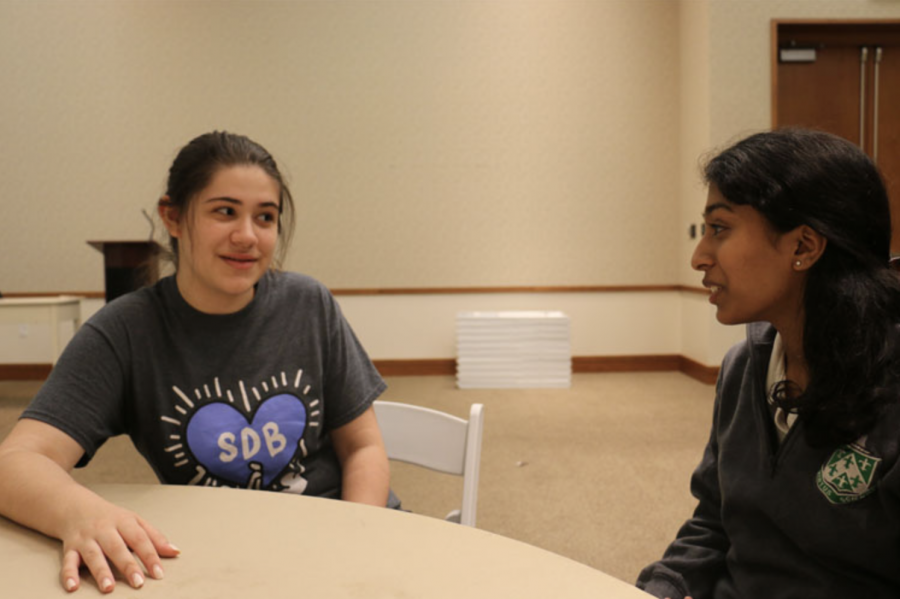PICTURED ABOVE // Working for change: Junior Isabella Yepes discusses mass incarceration with junior Tanvi Kongara after the Student Diversity Board forum. Photo by Charlotte Dross.
On April 6, Hockaday Upper School students gathered in Clements Lecture Hall for the third and final Student Diversity Board forum. Lead by 2018-2019 Chair junior Tanvi Kongara, the forum was held on the topic of mass incarceration. However, she, along with other SDB members, speak for themselves and not the entirety of the Board.
“The United States has 25 percent of [the world’s] incarcerated people, even though we only have five percent of the world’s population,” Kongara said. “The legislation starting years ago and then moving on, it categorized people, like ‘these people are more likely to commit these crimes.’”
In this day and age in which crime rates continue to soar, statistics like these show that the mass incarceration epidemic has plagued the country—in particular, minorities. Within the United States, 30 percent of the potion is comprised of either African Americans or Hispanics. However, they make up over 50 percent of those incarcerated.
Junior Isabella Yepes, 2018-2019 Assistant Chair of the Student Diversity Board, participated in the mass incarceration forum. She recognizes the gravity of the situation at hand.
“Mass incarceration feeds into larger issues of policing in the United States and education policy in the United States,” Yepes said. “Communities of color and underprivileged and underfunded communities bear the brunt of mass incarceration’s effects because of policies that police their neighborhoods at a discriminant rate.”
Bonton Farms, a staple of the Dallas community, is easily recognized by many Dallasites due to its trademark feature: goats. If you were to travel to the urban farming community, you would be hard-pressed to fail to find a furry, four-legged creature wandering about the premises of the farm. However, many do not know the story of its origins. Founded in the early 1900s, Bonton is the oldest black community in Dallas. Out of its primarily African American inhabitants, 85 percent of the men have served time in prison. Yepes is familiar with the Bonton community, along with the efforts its members have made to work past this statistic.
“[Bonton] is a poor community. A lot of them are under the poverty line. It is an inspirational message that Bonton Farms has been as successful as it has been. It’s an example of that rehabilitation effort—that you can have communities that can be focused on positive aspects that they built for themselves, and that is very helpful for them,” Yepes said.
However, mass incarceration is no new topic to the United States. Its lineage can be traced back as early as the late 19th century, when Jim Crow laws, which enforced racial segregation, dictated society. The racist mind- sets that existed—back then considered routine—partly accounts for why racism was able to flourish as it did.
During Richard Nixon’s presidency in the late ’60s and early ’70s, he campaigned on the idea of “Law and Order” because chaos and crime rates were constantly escalating. Yepes acknowledges that, at the time being, Nixon’s ideals of stability and security attracted many voters.
“[Mass incarceration] comes from a need to react against things that we think can hurt us, which is understandable. It is why Nixon’s appeal to law and order was so appealing. It is why his appeal to the common man—the silent majority—was so appealing,” Yepes said.
As Nixon normalized higher incarceration rates in an effort fight the “War on Drugs,” both Ronald Reagan and Bill Clinton took similar proactive stances, ultimately significantly increasing the amount of imprisoned peoples in an attempt to lower crime rates.
Upper School history teacher Lucio Benedetto is well aware of the adverse effects that the war on crime had on minorities both 50 years ago and still plays in our present-day society.
“Earlier in the ‘60s, there had been a bigger push for rehabilitation, and that kind of got pushed to the wayside in favor of longer-term sentencing,” Benedetto said. “I don’t think that the Clinton administration or the Reagan administration actually intended that this was going to grossly affect people of color in the way that it has, but that is what has happened.”
Today, a large portion of mass incarcerated peoples are nonviolent drug offenders. Al- though their crimes may not pose immediate threats to the public, because of the severity of laws surrounding drug use, they make up a
large portion of mass incarcerated population. Although drug use is a common crime that one may be convicted of, it is only one of a plethora of actions which lead people to be sentenced to prison. However, just as America saw the government severely crack down on drug use in the 20th century, today people are more frequently being convicted to serve long prison sentences for relatively minor crimes, leaving us as Americans to question the validity of the criminal system.
Race specifically comes into play when crime sentences are being determined. In a survey conducted by the American Civil Liberties Union, although both African Americans and whites used marijuana at nearly the same rate, those of color were arrested for possession at rates three times as high as the white users. This fact, along with the idea that minor crimes are now receiving larger sentences, ultimately leads to incarcerated peoples to fall into a cycle of poverty.
Benedetto is well aware of the discrepancies that exist among the different types of populations who are incarcerated. “The children in that family might be stuck in with parents who can only obtain very low income jobs, which means they are living in poorer parts of the cities that don’t have the better schools,” Benedetto said. “So you can create a cycle situation here, because the society can’t get past the stigma of the felon, the family gets caught in that situation.”
When one is incarcerated, not only is that person directly affected, but their loved ones must suffer the consequences as well. For low income families already struggling to make ends meet and living paycheck to paycheck, the incarceration of even one parent has a crippling effect on the rest of the family, significantly increasing the children’s chances of serving a prison sentence later in life.
“If you go to prison, you have to start your life back over all again,” Kongara said. “If you are the breadwinner of your family, then they won’t have any income coming into them, and that repeats the cycle of poverty, essentially. So [the family members] may have to do things that the [incarcerated] person had to do in order to feed themselves—like steal food.”
Texas in particular is not doing enough to lower these imprisonment rates or end these cycles of poverty. In an article published by the U.S. News and World Report in 2017, America was dubbed as the state that operates the country’s largest prison system, with 582 per every 100,000 people being incarcerated in 2014. These high numbers ultimately help feed into the school to prison pipeline, as minors and young adults are progressively being incarcerated due to harsh school and city district laws. Kongara recognizes the magnitude of the situation along with the effects that it has on a community as a whole.
“One of the reasons we decided to [hold the forum] on mass incarceration is because the Dallas ISD school to prison pipeline is enormous. The expulsion rate for African American or Hispanic students [in DISD] significantly higher than any other race,” Konga- ra said. “[The Student Diversity Board] thought that this was really interesting because a lot of Hockaday students do volunteer at these schools and so the child that they may be tutoring might eventually end up in prison.”
The idea that a young child may be destined to a life behind bars simply because of their appearance is unsettling. However, the fact that this is cycle of poverty is so high with- in the Dallas area serves to show that this issue demands to be dealt with. Yepes acknowledges the situation at hand and why it has dictated society for such an extended period of time.
“I think that one of our basic human urges is to try and react against fear and protect ourselves, but at the end of the day, this also does play into some implicit biases which are then corresponded into systemic laws,” Yepes said.
Story by Charlotte Dross.








